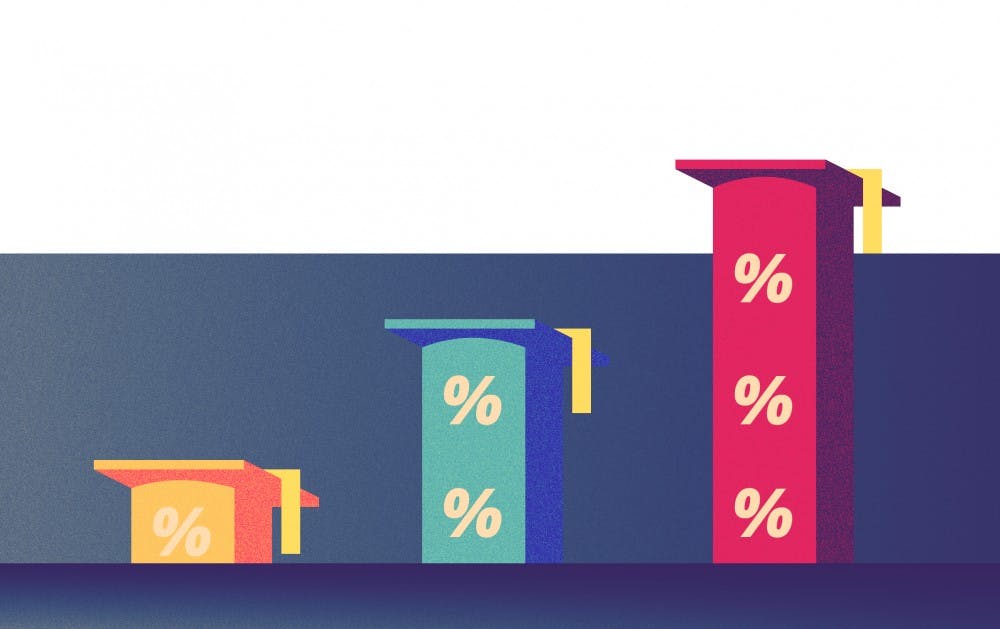Over 85 percent of ASU students are returning after their first year, eclipsing both the national average and the averages of UA and NAU, according to the new data about the class of 2020.
More than 85 percent of 2016 freshmen returned the following year, beating the national average of around 62 percent. The retention rates of UA and NAU are around 83 percent and 76 percent for the freshman class of 2016, respectively.
ASU's fall 2016 data is from the University Office of Institutional Analysis, which collects data on numerous topics such as retention, enrollment, new students, degrees and financial aid.
An institution's retention rate is the proportion of a school’s first-time, full-time freshmen that return to school the following year.
Arthur Blakemore, the vice provost for student success, said ASU’s high retention rates demonstrate how well the University is responding to students’ needs.
“It’s an indicator of how well you prepare students to come back for a second year ... you’ve engaged them and made them interested in coming back,” Blakemore said.
Mark Searle, the executive vice president and university provost, said ASU’s retention rate, or “freshman persistence,” falls under ASU’s dedication to its charter.
“We think it’s part of our social responsibility to our community to educate more students and to educate them well,” Searle said. “(Our) high retention rate says that we’re not only bringing them in, but we’re helping them to succeed.”
However, Dhanfu Elston, vice president of strategy at Complete College America, said retention rates aren't the only indicators of a school's student success.
Complete College America, which has connections with ASU, works to create policies and strategies to help increase graduation rates.
"We encourage institutions to look past one-year retention rates and look at four- and six-year graduation rates," Elston said.
ASU's graduating class of 2017 had a four-year graduation rate of about 53 percent even though the first-year retention rate for the entering class of 2013 was 85 percent, showing that many students leave ASU or drop out before graduation.
Similar disparities are seen for previous entering classes. On average, the disparity between retention rates and four-year graduation rates for entering classes between 2004 and 2013 is around 39 percent. However, some students take over four years to complete their undergraduate studies.
Since 2006, Blakemore said the leadership team at ASU has been focused on driving student success, and many solutions have been implemented in recent years.
“We’ve been increasing retention rates dramatically for the last 10 years,” Blakemore said. “Things that (students) are very familiar with like eAdvisor … ASU 101(course) … gateway courses, some of the gen ed courses … help with adaptive learning and that learning will raise the success rate.”
Improvements in retention rates have not been shared equally among all colleges at ASU.
The three colleges with the highest one-year retention rates are the School of Sustainability, with 92 percent and the Mary Lou Fulton Teachers College and the New College, both with 89 percent.
The three colleges with the lowest retention rates are the ASU Herberger Institute for Design and the Arts at 82 percent; the W.P. Carey School of Business and the College of Integrative Sciences and Arts, at 85 percent.
There is also a noticeable difference in retention rates between in-state and out-of-state students. For the entering class of 2016, the retention rate for out-of-state students is about 83 percent while the rate for in-state students is 89 percent.
Elston said although every situation has its own context, retention and graduation rates are not reflective of students, but the institutions themselves.
"The problem is not with the students," Elston said. "We make institutions look in a mirror and reflect on how they can better retain students for four years."
Searle said if students do feel like dropping out, they should speak to faculty right away.
“(Students should) reach out to us, to their adviser or speak to their professor or go to the department chair of their dean’s office,” Searle said. “We can help see whether there’s a pathway to help them stay in school or to at least plan for their return.”
Reach the reporter at mzhao49@asu.edu and follow @michelle_zhao23 on Twitter.
Like The State Press on Facebook and follow @statepress on Twitter.




